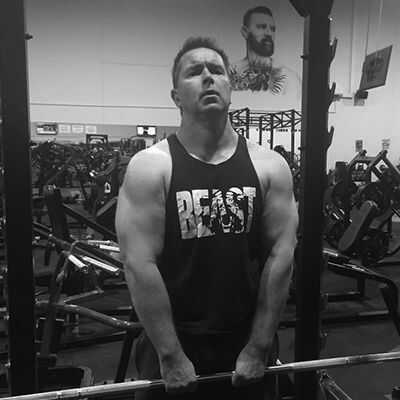By Steve Theunissen
Maintaining your fitness routine while travelling can be a real challenge. Whether you’re on holiday, taking a business trip or making an emergency excursion, travel threatens to interrupt the consistency of your workout program, potentially undoing all your hard work.
But it doesn’t have to be that way.
While bodyweight travel workouts may do the trick for some, others prefer to take their basic travel workout equipment along on their journeys. In recent years, a raft of portable workout equipment has flooded the market.
As a certified personal trainer, I’ve enthusiastically embraced many of them, recommending them to my PT clients who travel regularly.
In this article, I’ll break down the seven best travel workout equipment pieces for on-the-go training.
Here’s a preview of my seven key pieces of travel workout gear:
- Suspension Trainer
- Resistance Bands
- Ankle Weights
- Sliders
- Yoga Mat & Block
- Jump Rope
- Foam Roller
1. Suspension Trainer
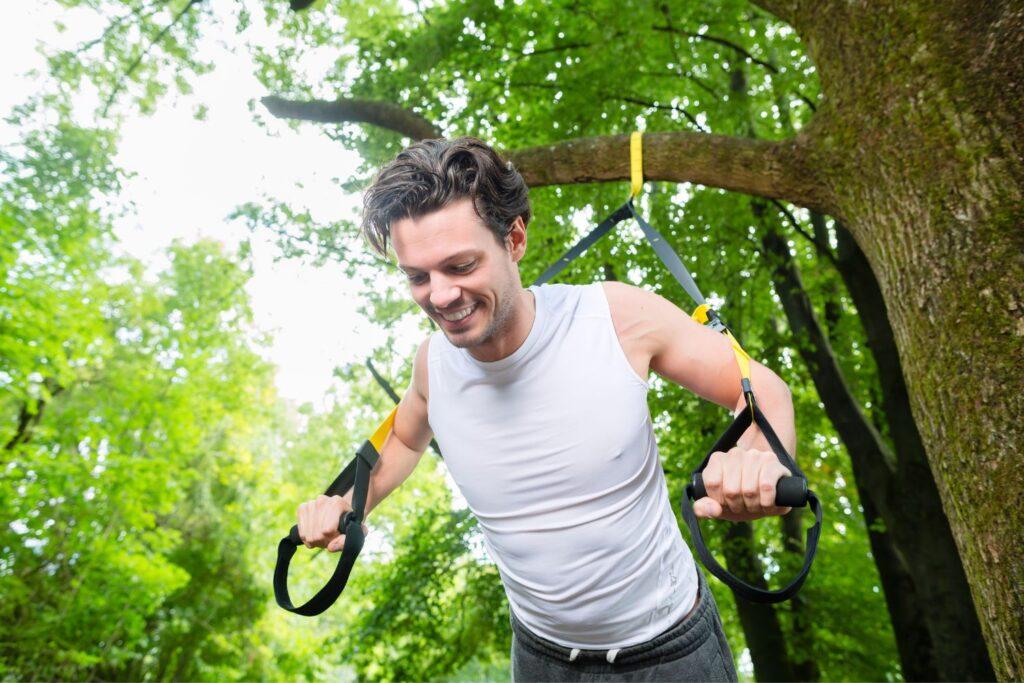
A suspension trainer is a portable fitness trainer designed to complement bodyweight training by allowing you to work at various angles. It consists of adjustable straps with handles and anchor points.
A suspension trainer will work every muscle in your body, with special emphasis on engaging the core to provide mid-air stability. By adjusting the angle that your body is moving through, you can increase or decrease the resistance. This variable resistance allows you to make your workouts progressively more challenging as you get fitter and stronger.
Suspension training requires you to keep your core engaged to stabilize your body to maintain control and balance. As a result, you’ll be working your abs, obliques, and intercostals even when your focus is on your biceps!
A suspension trainer kit is just as compact as a set of resistance bands, making it an ideal travel companion. The inclusion of a door anchor accessory, which is standard with most trainers, allows you to transform any hotel room, Airbnb, or other vacation spot into your personal gym.
Suspension trainers are also ideal for outdoor training. You can attach them to a fence post or tree and soak in the sun’s rays as you work up a sweat.
Check out this guide to find the best suspension trainers for your needs.
2. Resistance Bands
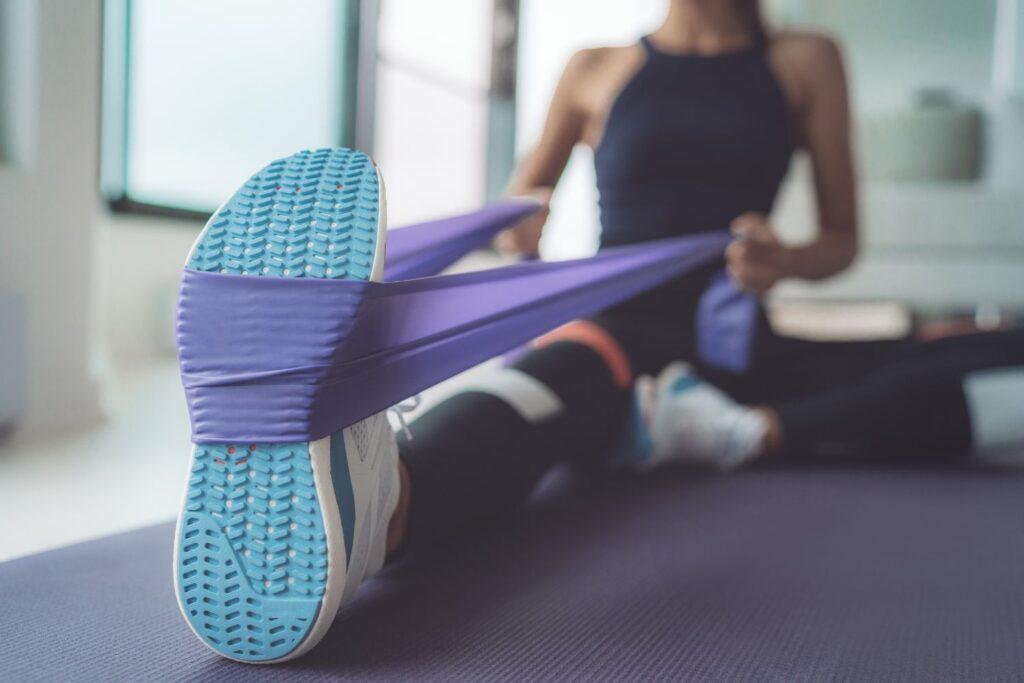
Resistance bands are easily my favourite piece of travel training gear. A full set of five bands weighs just a few pounds yet allows you to perform dozens of resistance exercises.
They take up next to no room in your luggage and are highly cost-effective.
Resistance bands are usually sold in sets with a range of colour-coded levels of resistance. They also come with an anchor strap, allowing you to make use of a closed door or other anchor point to create cable pulley simulations.
This allows you to simulate nearly every piece of resistance equipment found in your local gym right in your hotel room.
Some of my clients had the mindset that you can’t get a ‘real’ workout with resistance bands. That was before I took them through an intense upper body band workout. Now they’re resistance band believers. Here’s why resistance bands are the real deal:
- Variable Resistance: When the band is stretched during your exercise routine, it undergoes a gradual increase in resistance. This is different from free weights or bodyweight exercises, where the resistance remains static throughout the motion. As a result, resistance bands adapt to match your strength curve. This ensures that your muscles are challenged at every movement phase.
- Focus on the Eccentric Phase: The eccentric, or lowering, phase of an exercise involves the controlled lengthening of a muscle during exercise. Resistance band training encourages a deliberate, controlled descent during exercises such as squats. The band naturally opposes the muscle lengthening, forcing you to perform the eccentric phase with more precision.
- Explosive Concentric Phase: Band training allows you to safely use an explosive upward lifting motion with more power and speed than you can with free weights. A prime example is the band squat. In contrast to traditional barbell squats, where safety considerations may restrict explosiveness, resistance bands are designed for dynamic concentric action, introducing a dynamic dimension to your travel workout.
This resistance band guide is all you need to find the right resistance bands for you.
3. Ankle & Wrist Weights
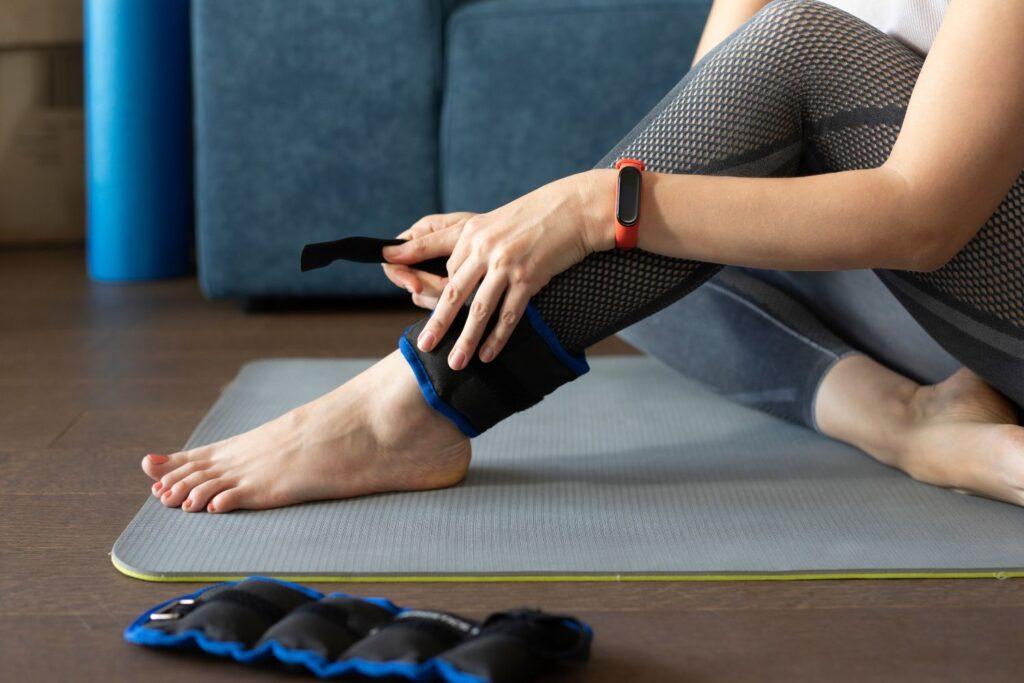
Ankle and wrist weights are weighted bands that are designed to be strapped to your limbs, providing extra resistance during bodyweight exercises. This is another compact, lightweight training device that will take up hardly any room in your luggage.
Weights are available in a range of resistances, from one pound up to 20 pounds. I recommend buying an adjustable set that allows you to add packets of resistance. These are usually in the form of iron or sand.
Ankle and wrist weights allow you to perform exercises that target your arms, like biceps curls, as well as those for the muscles of your lower body, such as donkey kickbacks. They can also be used to make your cardio and plyometric workouts more challenging.
Wearing them when you are walking or jogging will boost your endurance, elevate your heart rate, and increase your calorie burn.
4. Sliders
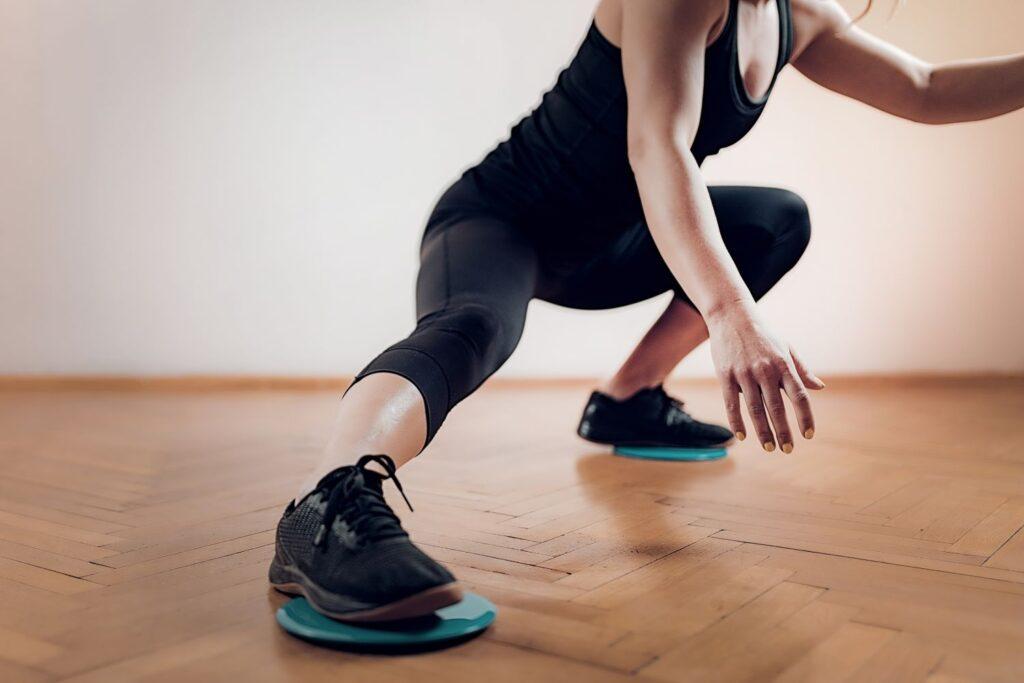
Exercise sliders are a highly underrated piece of travel workout equipment. Consisting of a pair of flat, round discs, they are designed to slide on a surface that you’re exercising on. They’re inexpensive, compact and lightweight, making them a no-brainer when it comes to travel and exercise.
In a similar way to suspension trainers, sliders create instability by allowing you to move your arms or legs while you’re doing an exercise. This brings your core into play to stabilize your body and promote balance.
A classic slider exercise is the slider push-up. In this exercise, you move your arms in and out as you do a push-up. The effect is a movement that mimics both the bench press and the dumbbell fly.
Here are half a dozen more exercises that are enhanced with a pair of sliders:
- Mountain Climbers
- Lateral Lunges
- Pike Sliders
- Single Leg Hamstring Curls
- Plank Knee Tucks
- Slider Leg Curl with Bridge
Sliders come in different materials to suit different surface types. If you’re working out on the carpet, you’ll want a plastic surface, while a tile floor requires a fabric covering for the best slide ability. The best sliders will have plastic on one side and fabric on the other to cover both options.
5. Yoga Mat & Block
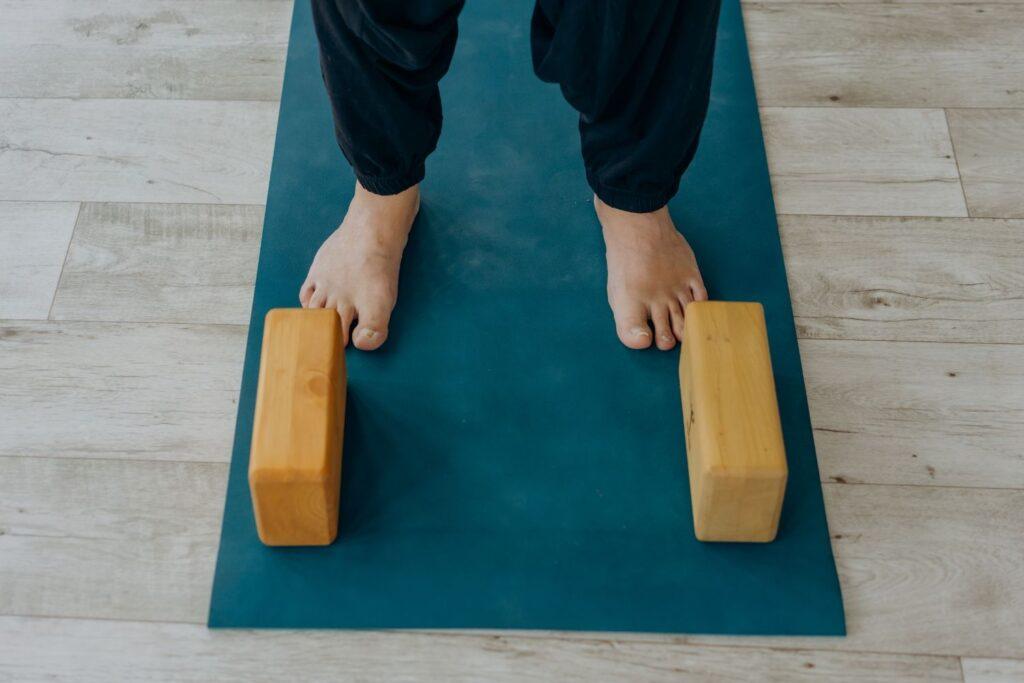
If yoga is part of your regular practice, a yoga mat and block should be among the first things you fit into your luggage. Even if it’s not, these two pieces of gear still rank highly on your essential travel workout equipment list.
A yoga mat provides a clean, comfortable surface to do your floor work on, be it asanas or bodyweight exercises.
You never know what chemicals or other compounds are lurking in hotel and Airbnb carpets, so having a quality mat between you and it is a health necessity.
The non-slip surface of a quality yoga mat provides a stable surface to work on. They also provide cushioning for your joints, reducing the compressive stress on your ankles, wrists, knees, and hips.
Yoga blocks provide stability and support when you’re doing yoga poses so you can maintain proper alignment and balance. They also help you deepen your stretches.
You can use blocks to make your bodyweight exercises more challenging. Use them to elevate your hand or foot position on exercises like push-ups and the plank.
6. Jump Rope
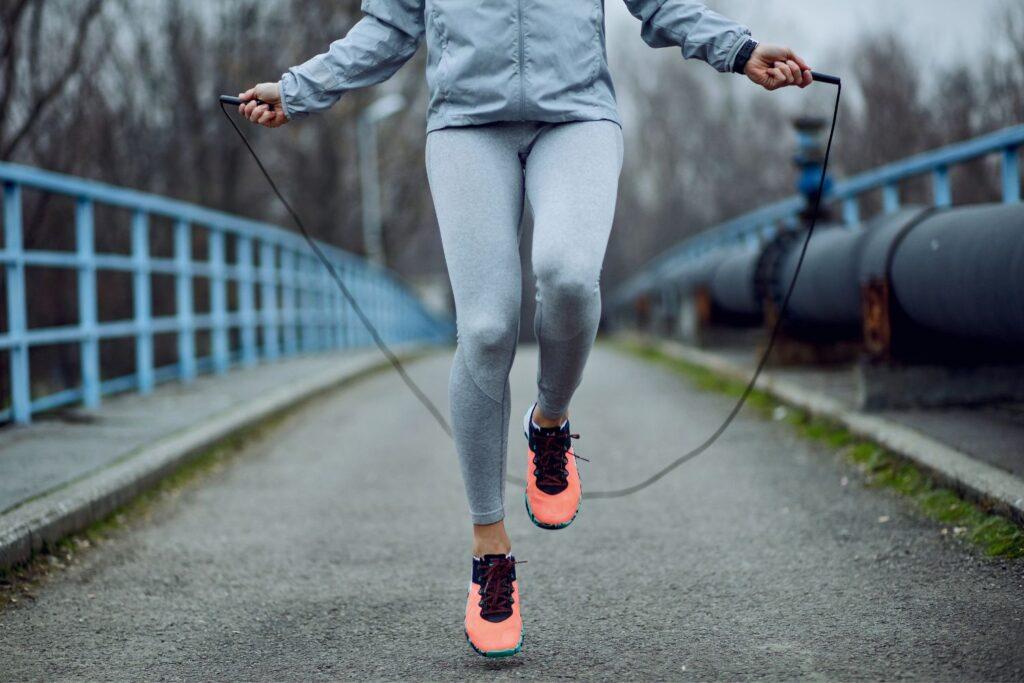
A jump rope is one of the most cost-effective, productive pieces of fitness equipment you can own.
It provides you with an excellent form of cardiovascular exercise that will get your heart racing as it churns through the calories and ups your endurance level. jump
You’ll burn more calories jumping rope than almost any other type of cardiovascular exercise. A 200-pound person who jumps rope for 20 minutes will burn an impressive 362 calories.
Jumping rope will also make you stronger. That 20 minutes of rope jumping will require thousands of revolutions of the rope. That’s thousands of reps involving the quads, glutes, hamstrings, calves, shoulders, and forearms.
Your muscular endurance and explosive strength will both improve as a result.
As an added bonus, jumping rope will also make your bones stronger. When confronted with the joint impact stress of ground reaction forces, the body’s stress adaptive response kicks in. This causes your bones to grow a tiny bit stronger to meet similar stress in the future.
In one study, Olympic-level swimmers experienced significant bone mineral density improvement after 22 weeks of twice-weekly 20-minute jump rope sessions combined with vibration therapy.
7. Foam Roller
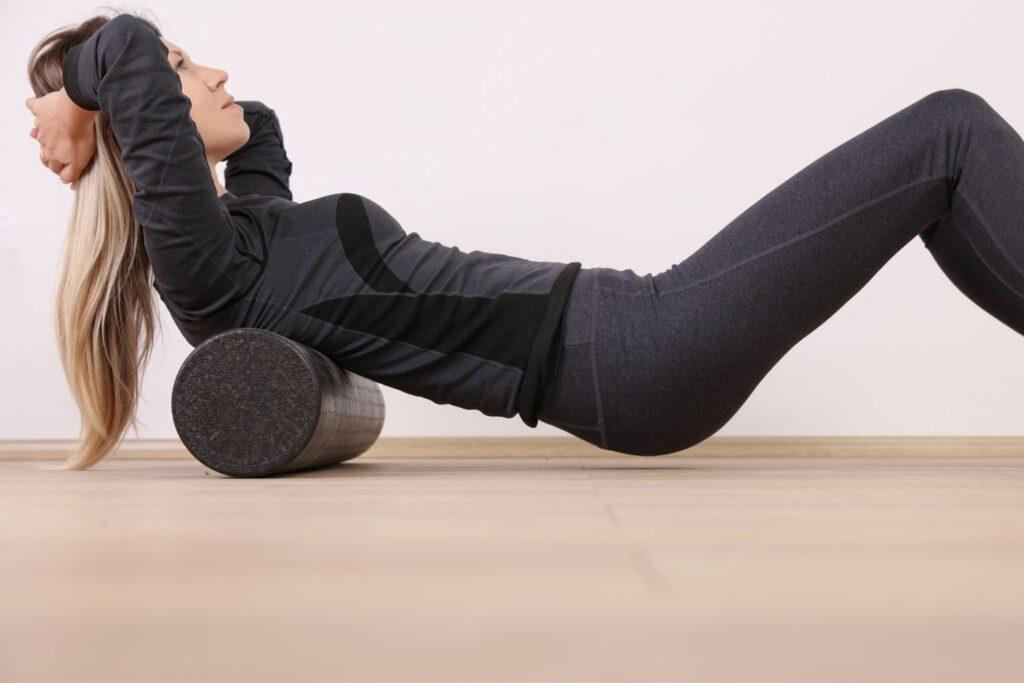
A foam roller is a cylindrical device that is usually about 18 inches long and made of a hardy form of plastic. It often features raised nodules or other patterns on its outer surface.
It is used as a self-massage device to allow you to apply self-myofascial release (SMR) in order to bring relief to specific pain points and to help with your recovery after a workout.
A foam roller is a lightweight, compact tool you can easily throw in your gym bag. You can use it in the warm-up/warm-down area of your gym straight after your workout or, if you prefer, wait until you get home.
Pack in your luggage when going on a trip, and you’ll have a portable recovery and self-massage solution to keep your muscles relaxed and pain-free throughout your travels.
5 Personal Trainer Travel Workout Tips
- Plan Ahead: Do some research before arriving at your destination. Search for nearby fitness facilities, parks, or running trails. Knowing your workout options in advance can help you stay committed to your fitness routine.
- Focus on bodyweight exercises: Exercises that require minimal equipment, like push-ups, squats, lunges, and burpees, should form the foundation of your workout.
- Short, Intense Workouts: Up the intensity and reduce the time of your holiday workouts. Experiment with various types of high-intensity interval training (HIIT) workouts that alternate between short, sharp bursts of activity with minimal rest between them.
- Exercise Early: Get your sessions in before your day gets hectic. If you’re on vacation with family or friends, plan to train while everyone is still sleeping, and your routine won’t interrupt the vacation fun.
- Don’t Be Too Strict: if you’re on holiday and travelling, embrace that experience without sacrificing your good habits. That goes for exercise as well as eating. It’s not the end of the world if you skip the odd workout or indulge in a treat or two. Confession time: even I enjoy comfort food once or twice each month, this corned beef stew being one of my favourite cheat meals.
Wrap Up
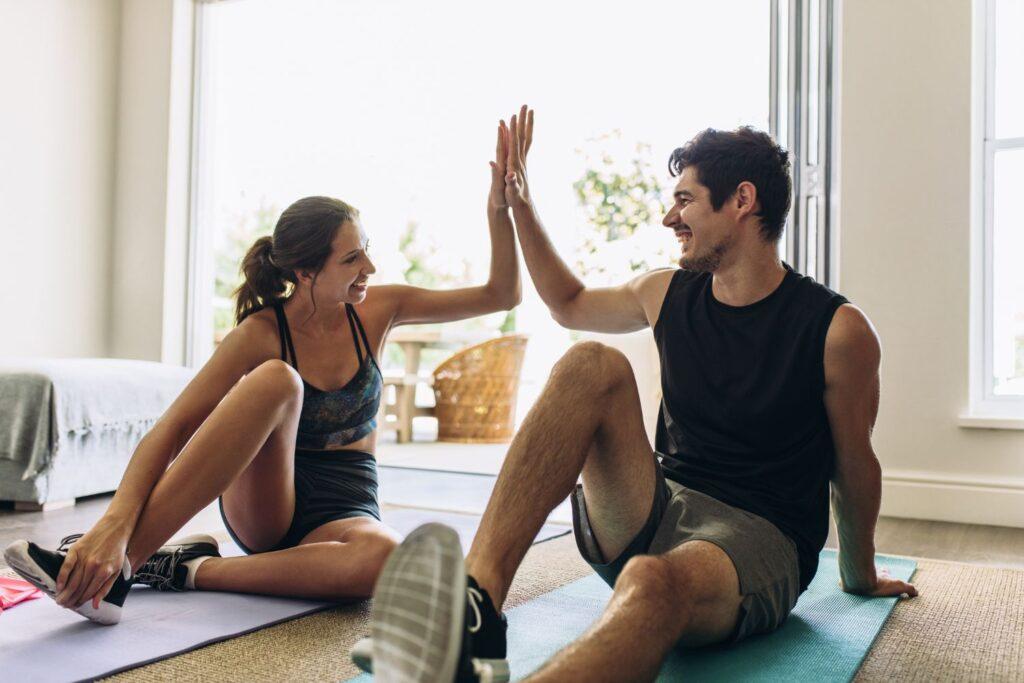
Maintaining your fitness routine while travelling can be a challenge, but it doesn’t have to be an insurmountable one. With the right travel workout equipment, you can stay on track with your fitness goals no matter where your journey takes you.
The seven pieces of travel workout gear we’ve covered offer a range of options to suit different preferences and fitness levels. From resistance bands and suspension trainers for versatile strength training to ankle and wrist weights for extra resistance during bodyweight exercises, these portable tools can transform any space into your personal gym.
Don’t forget the often-overlooked exercise sliders, which add a dynamic dimension to your workouts, and the essential yoga mat and block for comfortable and hygienic floor work.
A jump rope, one of the most cost-effective and efficient pieces of travel workout equipment, provides an excellent cardiovascular workout, while a foam roller offers self-massage and recovery benefits to keep your muscles relaxed and pain-free.
Remember to plan ahead, focus on bodyweight exercises, consider short, intense workouts, exercise early to avoid disruptions, and be flexible with your routine. That way, you’ll enjoy your time away while maintaining your healthy exercise habits.
Steve Theunissen joined his first gym at age 15 and, five years later, was managing his own studio. In 1987, he became the first personal fitness trainer in New Zealand, and over the past decade, he has built a freelance fitness writing career to share his fitness passion with the world.

